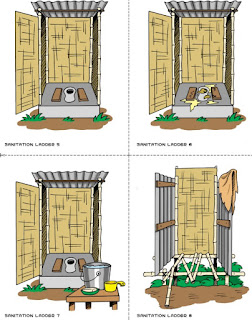Climbing the sanitation ladder...
Let's play an interesting game...
Analyse the following cards (from the Centre for Affordable water and sanitation technology: CAWST), rank them in order of most sanitary to least:

The truth of the matter is that this is not a game, but a reality of everyday life for around 4.1 billion people around the world. The 'game' does however raise interesting questions about evidence of 'progress' when we think about sanitation. The WHO has developed a very helpful guide on sanitation, one in which we can see the progress that a country or region is making, they call it the 'Sanitation ladder', in which presumably countries and regions are meant to climb rather than descend. The below example is from Water Aid and includes a description of each rung, as well as the number of people involved in that particular step.
 |
| Water Aid's Sanitation ladder |
India is often touted as an example of where governmental policy under the Swachh Bahrat (Clean India) has had a huge impact on sanitation, with over 4million toilets having been built by 2017, as illustrated by the map below:

However some question the use of 'toilets per household' as a measure of progress in sanitation, as illustrated by our card game, building a toilet doesn't necessarily mean that it will be used regularly or appropriately, as illustrated in the video below:
J Kwiringira et al(2014) support this view suggesting that "The extent to which latrines deliver the intended health benefits depends on how they are used. If latrines are properly used; not soiled, regularly and well cleaned, well covered and emptied in a timetly fashion and if hands are washed after use, latrines deliver enormous health benefits"
How are countries moving up the sanitation ladder?
How are countries moving up the sanitation ladder?
DowntoEarth suggest that Ethiopia has made significant progress when attempting to reach their sanitation targets on open defecation, with a 57.7% drop in open defecation rates since 2000. Over the same time period (1990 - 2015) India moved from 3 people in 10 using open defecation to 6, whereas in Ethiopia less than 1 Ethiopians used a toilet in 1990 and by 2015 this had increased to 7 in 10.
But the world of sanitation and statistics is complicated! Ethiopia, according to the charity Water Aid, has made the most significant progress, however is still the country with the 'most people who do not have access to decent toilets', only 7.1% of Ethiopians have access to basic sanitation. There appear to be 2 significant reasons for the progress that has been made, first Ethiopia has focused on 'behavioural change' rather than building toilets and the associated infrastructure. The second is that Ethiopia has focused on 'easy wins', in that it "has made significant strides in reducing the number of people at the bottom of the sanitation ladder ... through access to rudimentary community latrines."
This is, according to J Kwiringira et al(2014) an important step in moving up the sanitation ladder, "From a health perspective, the most critical movement is from no service (open defecation) or unimproved services to an improved sanitary facility". Importantly this helps them to achieve their Sustainable Development Goals on sanitation.
Perhaps the overarching reason for success in tackling sanitation issues however is more of a political one, the current government of Ethiopia has been in charge of the country for over two decades and has seen stability increase as a result.
Perhaps the overarching reason for success in tackling sanitation issues however is more of a political one, the current government of Ethiopia has been in charge of the country for over two decades and has seen stability increase as a result.
Progress on the sanitation ladder is complicated, as with many developmental measures it depends on how the measure is used, it also is not a linear progress as perhaps might be assumed. Even where significant progress is made, there remain significant challenges to ensure that everyone is able to access the services provided. In my next blog I will focus on sanitation and gender.





Excellent post. Very nicely structured around a fundamental issue and challenge. Reference to the peer-reviewed literature to substantiate some claims here would be desirable.
ReplyDeleteI really liked this post, mostly because of that 'behavioural change' you make reference too. I also wrote about the fact that infrastructure is necessary but not enough, or as you said in other words, the fact that building a toilet doesn't mean that it will be used appropriately... Hope we continue extending our research in this subject as a way of contributing to the appreciation of its importance!
ReplyDelete